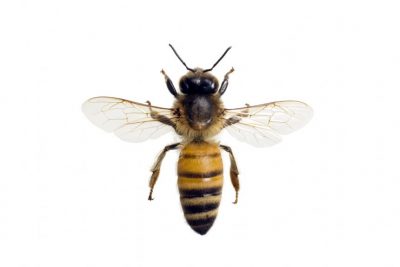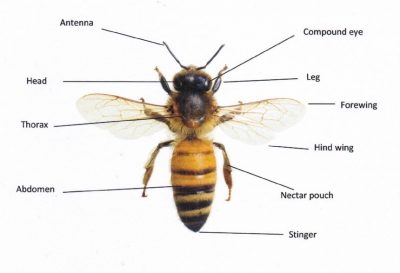Bees


Bees
Anatomy
Bees have six legs, four wings, nectar pouches and five eyes. The two rear wings are small and attached to the forewings with tiny hooks.
The two eyes either side of their head are compound eyes made up of thousands of lenses, the other three eyes are in the middle of their head and help the bee navigate whilst flying. They can’t see many colours. Their sight is limited to the blue – green colour spectrum. Red appears as black. However, they are able to see ultraviolet light, which helps them find flowers. Using these unique eyes they are also able to recognise people’s faces.
They carry their nectar pouches on their back legs. These pouches are made of stiff, curved hairs.
The stinger is covered in tiny barbs so when a bee uses its stinger, it detaches from their abdomen and they die.
Habitat
Honey bees live in large colonies in hives which they keep very tidy. There can be over 20,000 bees in a colony with one queen. The hive is made from a mixture of beeswax and resin collected from trees. Beeswax is secreted from wax producing glands in the bee’s abdomen. Inside the hive are perfect hexagonal combs made of beeswax called honeycomb. The queen lays her eggs and the workers store honey and pollen in the honeycomb.
In comparison, bumblebees live in underground burrows that have been discarded by mice or other small rodents. The nests have several entrances and are approximately 30cm wide.
Diet
Bees feed on nectar and pollen from flowering plants. Nectar is a sugary liquid that gives bees energy. As it collects this nectar and pollen it pollinates the plants, which helps them to grow. The nectar and pollen is used to make honey. The honey will feed the bees throughout the whole year.
Birds, frogs and newts eat bees.
Lifecycle
A queen can live up to five years. If a queen dies, the workers select a newly-hatched-larvae and feed it royal jelly so it will grow into a replacement queen. The bees make royal jelly by mixing pollen and honey with a special chemical produced by a gland in the nursing bees’ heads.
The queen’s role is to lay eggs. She also produces special chemicals which influence the other bees’ behaviour. She lays her eggs in small batches on a ball of pollen covered by wax. The larvae will feed on the pollen as they grow. The queen will sit on her eggs to keep them warm until the first workers are born.
Workers are all female. It takes about three weeks for them to be born. It is their job to collect food, build and protect the hive, clean and circulate the air by beating their wings. Adult worker bees will live about four weeks. However, some die in as little as five days. It can take about five weeks for a worker bee to become adult.
The male bees are called drones. It is their job to mate with the queen. A queen will only mate once with each male. In the winter the drones are thrown out of the hive.
Behaviour
Bees will fly the shortest route possible between flowers and can fly over 25km an hour. Their wings beat over 200 times a second. However, they can not fly if they are too cold (below 30˚C). They use the sun and other landmarks to find their way.
They have an excellent sense of smell to help them recognise different varieties of flowers. Each colony has its own odour so the bees know where they live. As well as using their sense of smell to communicate bees can communicate by dancing. The faster the dance the more food there is.
Bees use a process known as buzz pollination to pollinate plants, such as tomatoes. They do this by producing a high-pitched buzz whilst holding on to the plant.
Different species
There are over 20,000 different species of bee worldwide, which vary in colour. Some have bands of red and black, some yellow and black, some orange and black, or even white and black. Bumblebees and honey bees are the two most common species and they have many differences between them:
• Honey bees
Honey bees have a barbed stinger. They live in large colonies of over 50,000 bees. They keep their hives extremely tidy. Honey bees swarm. About sixty percent of the worker bees leave the original hive with the old queen to find a good location to build a new hive.
During the winter honey bees will hibernate and feed on the honey they have collected during the summer months. They cluster around the queen inside the hive to keep warm, ensuring the temperature stays around 34˚C.
• Bumblebees
Bumblebees live in small colonies of up to 400 bees. They only produce a small amount of honey for their needs. They do not make enough for beekeepers to harvest. They keep their honey in tiny wax cups, which are strewn in a disorderly fashion around their very untidy nests.
Male bumblebees do not have a stinger. Female bumblebees can sting more than once as their stinger is smooth, not barbed like the honey bee. However, they do not usually live the whole year, so the bumblebee queen will hibernate alone over the winter.
Both Honey bees and bumblebees are in decline. This is very serious as bees are the main pollinators of not only wild flowers but also crops, so play a key role in our food production. The cause of this decline is the loss of habitat and also Varroa Destructor mite, which kills the bees and spreads diseases to their larvae. However, increased use of pesticides may destroy the mite but kills the bees as well. In fact, the Varroa Destructor mite has become immune to many of the pesticides used.
We can help the bees by growing more wild flowers for them to pollinate, providing nest sites for bees and avoiding the use of chemical pesticides. Together we can make a difference.
